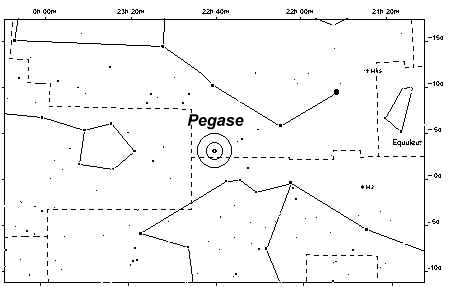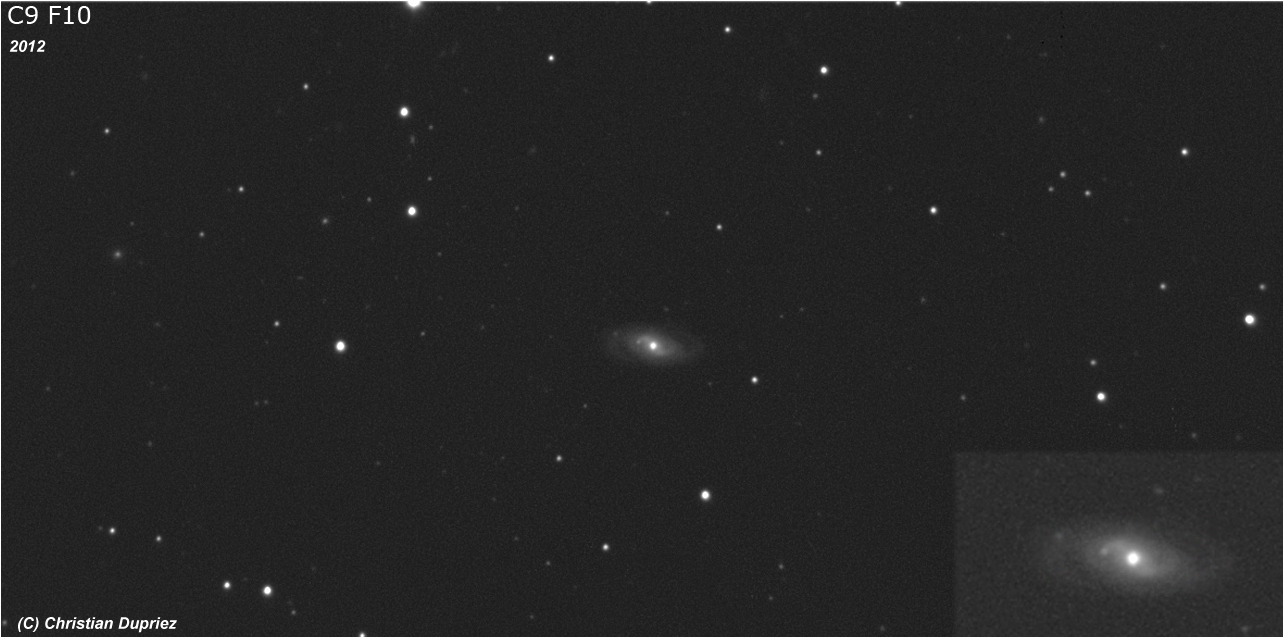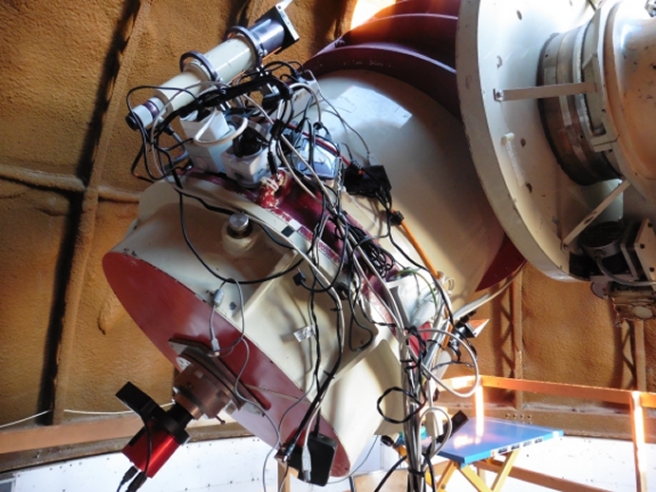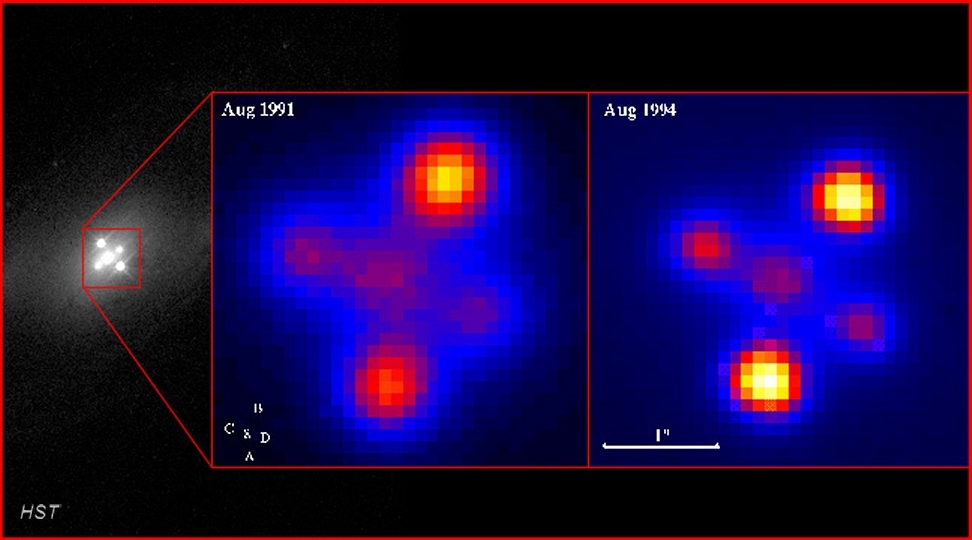
ASTROQUEYRAS
- MISSION 2017 - W38


TOPIC :
Deep Sky Imaging "Very High Resolution and Lucky
Imaging".
MAIN TARGET
:
The Einstein Cross -
a special form of a gravitational mirage corresponding to the visual
multiplication of the Quasar image QSO2237 + 0305
https://fr.wikipedia.org/wiki/Croix_d%27Einstein
The host galaxy, CGCG 378-15 or PGC 69457 is in the constellation Pegase.
|
 |
 |
||||||||||||||||||||
 |
 |
Here is an example of a chance alignment whose
probability boggles the mind. However, in a Universe the size of our own even
the seemingly impossible happens every so often. In the foreground is a small
barred spiral galaxy- PGC 69457. Given a value of Hubble's constant of 75- this
galaxy is roughly 500 million light years away. Think that is incredible? Look
closely at the nucleus of this galaxy, it appears to have four parts! While
questionably resolved in this amateur image, HST images of the same clearly show
this strange feature. The four images are not of the nucleus of PGC 69457,
instead they are images of a background quasar! (QSO2237+0305). This quasar
(very luminous galaxy of the early Universe) is around 13 billion light years
away! The mass of PGC 69457 changes the geometry (curvature) of space. As the
light of the quasar passes near to the foreground galaxy, it acts like a lens
and shows us multiple images of the background quasar. This is one of the best
examples of the effect that Einstein postulated in the early 1900's (and much
later detected in this example in 1989 (Huchra et al). More recently astronomers
have discovered that the four images change in their relative brightness due to
stars in the foreground galaxy. By measuring the difference of time of these
variations astronomers can learn a lot about both objects.
OBJECTIF and challenge :Separation of the 4 images of the quasar forming the cross on the bottom of the galaxy.
Separation test, on an image of our friend Christian Dupriez , initiator of the challenge ! http://www.astrosurf.com/chd/ Caméra SBIG ST10 XME / C9 F10 long exposures . around Lille .
 |
ADVANTAGES OF THE "STATION SAINT - VERAN " - Pic Château-Renard 2936 m - in the Hautes Alpes (05). http://www.astroqueyras.com/
High mountain observatory at 2936 meters - Seeing very good - one of the best in Europe . Acquisitions on 21/09/2017 around 22:00 UT.
 |
 |
 |
High-performance telescope under a 7.5m dome (one of the 2 domes of the Observatoire de Paris!): T620 mm - Cassegrain, open at F15 - 9000mm focal length. Focusing by moving the secondary mirror.
 |
 |
CMOS camera:
ZWO ASI 1600 monochrome cooled with a very low readout noise .
https://astronomy-imaging-camera.com/products/usb-3-0/asi1600mm/
Sensor: 4/3″ CMOS
Diagonal: 21.9mm
Resolution: 16Mega Pixels 4656×3520
Pixel Size: 3.8µm
Max FPS at full resolution :23FPS
Shutter: Rolling shutter
Exposure Range: 32µs-2000s
Read Noise: 1.2e @30db gain


With a focal length of 9000 mm, sampling of the sensor (pixel of 3.8 microns) is E = 206 x3.8 / 9000 = 0.1 arcsec/ pixel .
ACQUISITION CONDITIONS :
Image with very short exposures as 1s to limit turbulence, avoid saturation of thecore and work without autoguiding .
 |
 |
Telescope control room and search for the target under PRISM ..... warm ! |
Improvisation of an office under thetelescope for the acquisition with Fire Capture and and ae permanent control of focusing..... in the cold ! |
To get a nice picture to look at, we chose to realise 2 kinds of images!
A first serie of 1000 images of about 1s
and 100 retained after sorting, and a second of 500 poses of 10s and 200
retained. A gain of
300 was considered reasonable not to saturate the brightest parts!
A relatively close star, magnified to 300%
allowed us to control and redo the focus very often.
Temporary stop of the acquisition, readjustment of the map and
revival of the exposures
!
Severe sorting on the FWHM, sometimes sub-second
arc, as well as the rate of elongation was necessary!
No autoguiding despite 9m focal length
!
On this camera the brightness should be adjusted
with the gain to avoid having a sky background at zero (blue histogram in
FireCapture). Acquisitions of Flat (on
screen) and dark at -30 ° C regulated at the end of the night (after
installation of the cover).
 |
 |
PROCESSING with IRIS rigorous and well proportioned not to create artifacts or additional noise. Logarithm to desaturate the core of the galaxy !
And to fight against the cold and fatigue,
nothing like a little frying ..... without being distracted
:-)

THE RESULTS
Pro's images !
 |
FINAL IMAGE :
Processcd by Christian Dupriez ( from our pre-processed images) with IRIS and Photoshop .
Crop on the galaxie at 100%
 |
| Successful challenge under not optimal conditions - Seeing 7/10 |
 |
| Image in false colors! |
 |
| Field of the image at acquisition - reduced to 25% - FOV: 7'X5 ' |
 |